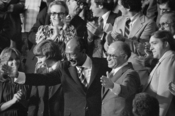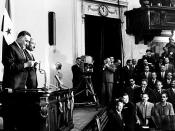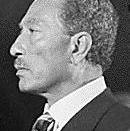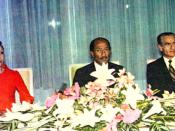Jihan Sadat: The Woman Who Opened The Doors To A Better Life For Egyptian Women Jihan Sadat is the most influential women's rights activist in modern Egypt. Jihan Sadat is the wife of former leader of Egypt, Anwar Sadat. She raised four children while being a politician, and earned a doctorate in English literature from Cairo University. I will show you my findings of Mrs. Sadat's life and how she influenced modern Egypt.
Jihan Safwat Raouf was born in 1934 to parents Safwat Raouf, and Gladys Mary Cotrell. Safwat Raouf, her father, was a physician, judge, and civil servant. Gladys Mary Cotrell, her mother, was an English Schoolteacher. Jihan's daughter, Camellia once wrote: "Jihan's parents were like a United Nations in human form. The father was of Egyptian and Turkish extraction, the mother was of Egyptian, British, and Turkish lineage."ÃÂ(Moritz, 276) Jihan has two brothers and three sisters, and was raised as a Muslim Arab, even though her mother was British.
Although her mother was not Muslim, she valued her children's religious upbringings, so she helped them by observing many Muslim holidays with her children. For example, she fasted in the month of Ramadan to be a good example for her children. In a Muslim society with men being superior over women, Jihan's father never favored his sons over his daughters, as was common practice in those days.
She attended an Egyptian missionary girl's school whose owner was a friend of her mother's from age twelve. She later transferred to a secondary school, where she met future husband, Anwar Sadat, before the age of fifteen. At the time, Anwar was twenty-nine years old, penniless, just divorced, and a former political prisoner of the British. (Rashdan, line 51) He spent thirty-one months in prison, eighteen in solitary confinement. Of course, Jihan's parents objected to the man, but they got married anyway on May 29, 1949.
By 1954, Jihan was busy raising four children. Three daughters: Loubna, Noha, and Jihan, and son: Gamal. In 1967, Jihan decided that she wanted to help her community, and became more active, and started to visit wounded and disabled soldiers from the war with Israel as an Egyptian Red Cross volunteer. In the same year, she made a plan to establish a self-help cooperative in Talla, a village in the Nile Delta. In 1969, Jihan spoke at a meeting of the Monufiya People's Council. She would speak there twice a month for four years. Later that year in December of 1969, Anwar Sadat was named Vice President of Egypt behind Nasser. In 1974, Jihan enrolled into Cairo University and earned her Bachelor's and Master's degrees in Islamic Literature. After Anwar Sadat was named leader of Egypt, Jihan established the Wafa Wal Amal Rehab Center, aka Faith and Hope City, on 160 acres of land near Cairo. The rehab center was for people who needed medicare, but could not afford it, hence the name Faith and Hope City.
Jihan Sadat had a big effect on how women in Egypt live today. In 1970, at the first official reception after Anwar became leader of Egypt, Jihan stood radiantly next to her husband to signify that unlike Nasser's wife, she would be seen and heard. She believed that women in Egypt didn't have the rights they deserved, so that is what motivated her to fight for women's rights in Egypt. In the spring of 1979, Anwar issued two decrees that gave women more political power and family status. The first decree that is about politics stated that at least thirty out of the three hundred and sixty seats in Egypt's People's Assembly must be devoted to women. This would make it five percent higher than the US requirement! The first decree also stated that one fifth of all members in Egypt's twenty-six local assemblies must be women. The second decree that is about family states that the first wife of a man could sue the man for a divorce if she disapproves of the man's second wife. This was in a time when polygamy was commonly practiced and women had no say in her husband's second wife. The second decree also changes the custody laws for divorced families. Before, the rule was that all children up to nine years old would stay with their father. The decree changes it by stating that all children up to sixteen years old will stay with their mother. Jihan takes little credit for these decrees and states that Anwar issued the decrees because he recognized the contributions of women to Egypt. As you may suspect, this raised great controversy, especially among many religious people and Egyptian males.
After her husband was assassinated, Jihan went into a mourn for over a year before she was called to Washington DC in October of 1982 to accept the American Medal Of Freedom Award. She still wore black for quite a while before she finished mourning. She came back to the US in 1983 too receive an honorary LLD degree from the University of Vermont. In 1984, she joined up with Margaret Papandreou, the wife of the Greek prime minister, to review the progress made during the UN's Decade For Women. In 1985, she taught a course at the University of South Carolina called "Women in Egyptian Culture."ÃÂ Finally, in1986, she went back home to the University of Cairo to earn her doctorate in English Literature.
This is the story of Jihan Sadat, the woman who helped revolutionize the lives of Egyptian women today. In my opinion, I think her parents had a lot to do with how successful she became. She luckily married the right guy, but how her parents acted as opposed to any other average parents made the difference between Mrs. Nasser: Wife of Gamal Abdul Nasser, and Not Much Else, and, Jihan Sadat: The Woman Who Opened The Doors To A Better Life For Egyptian Women.
Bibliography 1. Byers, Paula. Encyclopedia of World Biography, Detroit: Gale Research, 1998 2. Moritz, Charles. Current Biography Yearbook 1986, New York: HW Wilson Company, 1987 3. Rashdan, Dalia. A Tribute To The Egyptian Woman. May 14, 2001. http://rock.eng.uop.edu/students/dmohammed/ewoman.html.
4. Robinson, Francis. Islamic World, New York: Cambridge Press, 1996





